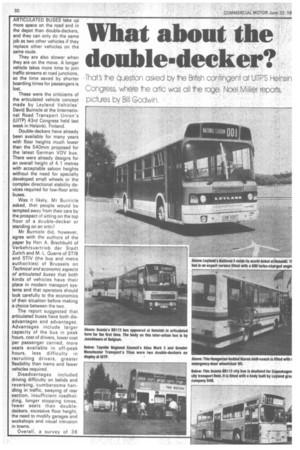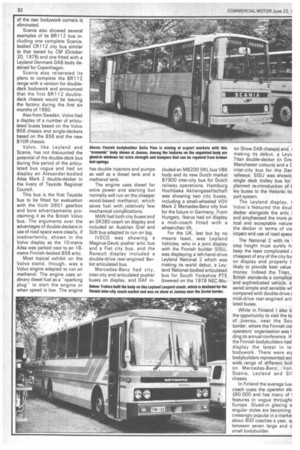What about the double-decker?
Page 32

Page 33

Page 34

If you've noticed an error in this article please click here to report it so we can fix it.
That's the duestion asked by the British contingent at UR'S Helnsin Congress; where the artic was all the rage, Noel Millier reports; pictures by Bill Godwin
ARTICULATED BUSES take up more space on the road and in the depot than double-deckers, and they can only do the same job as two other vehicles if they replace other vehicles on the same route.
They are also slower when they are on the move. A longer vehicle takes more time to join traffic streams at road junctions, so the time saved by shorter boarding times for passengers is lost.
These were the criticisms of the articulated vehicle concept made by Leyland Vehicles' David Burnicle at the International Road Transport Union's (UITP) 43rd Congress held last week in Helsinki, Finland.
Double-deckers have already been available for many years with floor heights much lower than the 540mm proposed for the latest German VOV bus. There were already designs for an overall height of 4.1 metres with acceptable saloon heights without the need for specially developed small wheels or the complex directional stability devices required for low-floor artic buses.
Was it likely, Mr Burnicle asked, that people would be tempted away from their cars by the prospect of sitting on the top floor of a dcuble-decker or standing on an artic?
Mr Burnicle did, however, agree with the authors of the paper by Herr A. Brechbuhl of Verkehrsvertrieb der Stadt Zurich and M. L. Quarre of STlB and STIV (the bus and metro authorities) of Brussels on Technical and economic aspects of articulated buses that both kinds of vehicles have their place in modern transport systems and that operators should look carefully to the economics of their situation before making a choice between the two.
The report suggested that articulated buses have both disadvantages and advantages. Advantages include larger capacity of the bus in peak hours, cost of drivers, lower cost per passenger carried, more seats available in off-peak hours, less difficulty in recruiting drivers, greater flexibility than trams and fewer vehicles required.
Disadvantages included driving difficulty on bends and reversing, cumbersome handling in traffic, swaying of rear section, insufficient roadholding, longer stopping times, fewer seats than doubledeckers, excessive floor height, the need to modify garages and workshops and visual intrusion in towns.
Overall, a survey of 36 undertakings found nine advantages in operating artics and 27 disadvantages although generally the advantages were more important than the disadvantages. The report also described the different types of artic buses available including pushers (rear-engined rear-axle-drive) buses, rear-engined mid-axledriven buses, rear-axle doubledriven buses and the more usually mid-engined mid-axledriven artics. The report very briefly acknowledged the role of the double-decker as a potential alternative to the artic and listed the following advantages: double-deckers accommodate more seated passengers, traffic circulation is easier, approaching and leaving stops is easier, boarding heights are lower and there are fewer technical complications. In the debate which followed, speakers from as far afield as Budapest and Tel Aviv spoke in favour of articulated bus operation, while Britain's Peter VVyke-Smith of the National Bus Company and David Burnicle of Leyland Vehicles stood up strongly for the double-deck concept. Despite the strong arguments in favour of doubledeckers, the authors concluded that articulated buses are advisable on heavily loaded routes, especially if they have the benefit of various traffic priorities such as bus lanes and priority at junctions. After outlining a report on the activities of the International Commission for the Study of Motorbuses, M. Yves Savary of Regie Autonome des Transports Parisiens from Paris presented a report on The energy problem in public transport by motorbus which concluded that "Although the quantity of energy used by buses is proportionately small, operators must make every effort, in their own interest, as much as that of the community, to seek and implement means of energy conservation. "Appreciable results, which of course depend on many factors, may be obtained by applying to rolling stock technical measures already now available, and which can be improved, by organising the services in such a way as to meet the demand in the optimum fashion with smaller energy consumption, by encouraging the awareness of staff to energy problems and by training bus drivers in the economic use of fuel. -Moreover, a policy of priority and promotion of public transport, which depends on public authorities to a large extent, can, by diverting a certain number of private car drivers to travel by bus and other means of public transport, contribute significantly to energy savings on a collective level". Other reports in the technical sessions of the congress, which where followed by open debates, included Adjustment of Surface public transport supply to urbanisation trends, from the International Commission on traffic and urban planning, The long-term role of public transport by the International Commission on Prospective Study of Public Transport, and a report on Public transport public relations functions, Regional transport evaluation and Traffic evaluation metropolitan railways and light rail were also discussed before the International Commission for the Study of Motorbuses had a chance to present its report on the artic bus — a debate which was shortened by the overenthusiasm of tram enthusiasts in the light rail debate. Helsinki gave also bus manufacturers probably their best opportunity yet this year to show their products to a world market. Several manufacturers chose Helsinki to launch new vehicles on the world market.
Scania Bussar of Sweden launched a new articulated version of its BR112 rear-engined bus. The Scania artic consists ol the rear sections and front sections of the BR112 chassis divided into control and drive modules with a new body buili by Jonckheere of Belgium anc the centre articulated sectior supplied by Robert Scherk Gmbh of Germany. The 17.4-metre Scania artic is powered from the rear trailei axle. Scania says that with the engine driving the rearmost axle, the artic can incorporate standard body and chassis corn. ponents used in rear-enginec two-axle buses and by usinc. fixed-centre rear axles, "sweep'
of the rear bodywork corners is eliminated.
Scania also showed several examples of its BR112 bus including one complete Scaniabodied CR112 city bus similar to that tested by CM (October 20, 1978) and one fitted with a Leyland Denmark DAB body destined for Copenhagen.
Scania also reiterated its plans to complete the BR112 range with a version for doubledeck bodywork and announced that the first BR 112 doubledeck chassis would be leaving the factory during the first six months of 1980.
Also from Sweden, Volvo had a display of a number of articulated buses based on the Volvo B58 chassis and single-deckers based on the B58 and the new B1 OR chassis.
Volvo, like Leyland and Scania, has not discounted the potential of the double-deck bus during this period of the articulated bus vogue and had on display an Alexander-bodied Ailsa Mark 2 double-decker in the livery of Tayside Regional Council.
This bus is the first Tayside bus to be fitted for evaluation with the Voith D851 gearbox and bore advertisements proclaiming it as the British Volvo bus. The arguments over the advantages of double-deckers in use of road space were clearly, if inadvertently, shown in the Volvo display as the 10-metre Ailsa was parked next to an 18metre Finnish-bodied B58 artic.
Most topical exhibit on the Volvo stand, though, was a Volvo engine adapted to run on methanol. The engine uses ordinary diesel fuel as a "sparking plugto start the engine or when speed is low. The engine
has double injectors and pumps as well as a diesel tank and a methanol tank.
The engine uses diesel for extra power and starting but normally will run on the cheaper wood-based methanol, which saves fuel with relatively few mechanical complications.
MAN had both city buses and an SR280 coach on display and included an Austrian Graf and Stift bus adapted to run on lpg.
IVECO was showing a Magirus-Deutz pusher artic bus and a Fiat city bus, and the Renault display included a double-drive rear-engined Berliet articulated bus.
Mercedes-Benz had city, inter-city and articulated pusher buses on display, and DAF in cluded an MB200 DKL bus VBK body and its new Dutch market B7900 inter-city bus for Dutch railway operations. Hamburg Hochbake Aktiengesellschaft was showing two city buses, including a small-wheeled VOV Mark 2 Mercedes-Benz city bus for the future in Germany. From Hungary, Ikarus had on display a midi-coach fitted with a wheel-chair lift.
For the UK, last but by no means least, was Leyland Vehicles, who in a joint display with the Finnish builder SISU, was displaying a left-hand-drive Leyland National 2 which was making its world debut, a Leyland National-bodied articulated bus for South Yorkshire PTE (lowered on the 1978 NEC Mo tor Show DAB chass) and, ; making its debut, a Leyl; Titan double-decker (in Gre; Manchester colours) and a inter-city bus for the Dar railways. SISU was showin single deck trolley bus for planned re-introduction of t ley buses to the Helsinki trE port system.
The Leyland display, I Volvo's featured the dout decker alongside the artic I and emphasised the more pi tical and acceptable nature the decker in terms of vis impact and use of road space The National 2 with its I step height must surely h; beep the least complicated cheapest of any of the city bu on display and properly t likely to provide best value money. Indeed the Titan, British standards a complica and sophisticated vehicle, a eared simple and sensible wt compared with double-drive E midi-drive rear-engined arti lated buses.
While in Finland I also t( the opportunity to visit the to of Joensu, near the Soy border, where the Finnish coi operators' organisation was !ding its annual conference. H the Finnish bodybuilders had display the latest in bodywork. There were eic bodybuilders represented wit wide range of different bod on Mercedes-Benz, Voh Scania, Leyland and SI: chassis.
In Finland the average luxt coach costs the operator abi £60,000 and has many of 1 features in vogue through( Europe. Glued-in glazing a angular styles are becoming creasingly popular in a markei about 800 coaches a year, si between seven large and o small bodybuilder.




























































































































































































